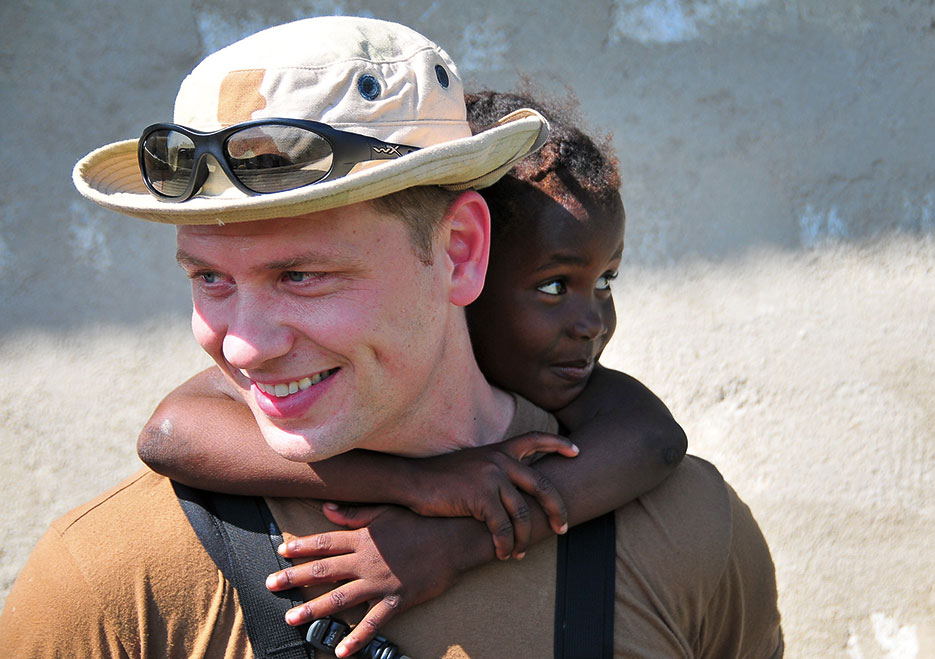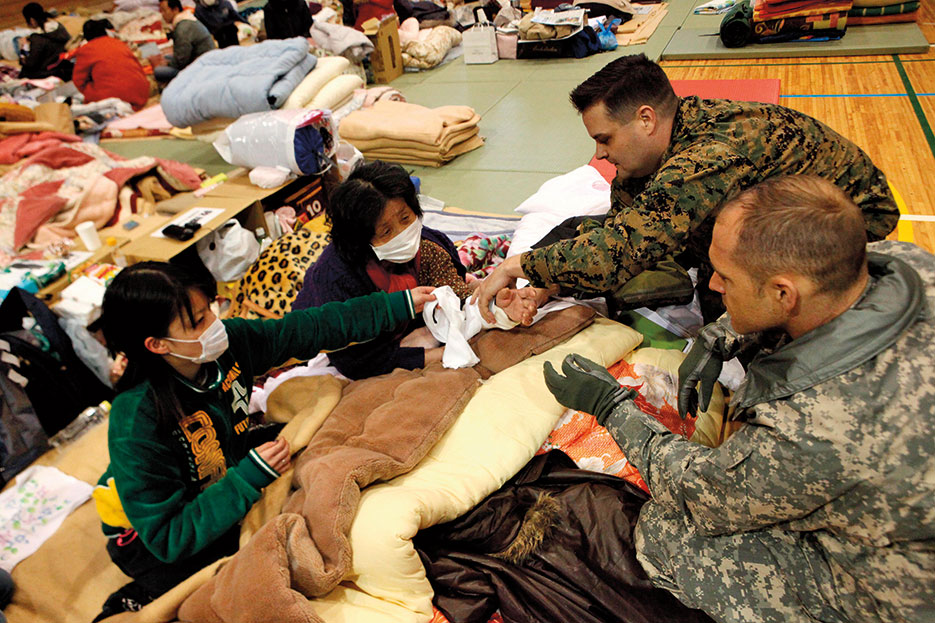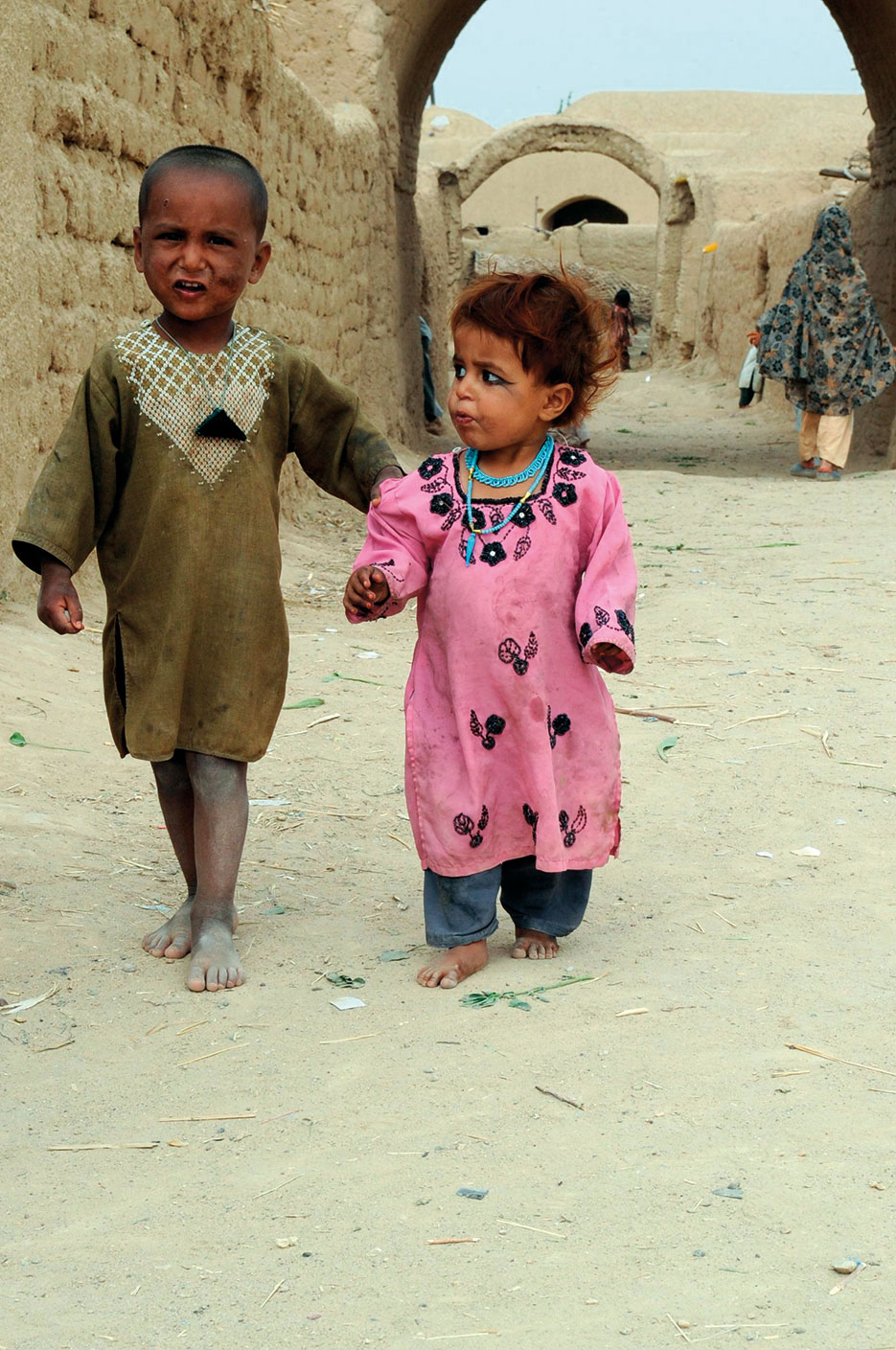Журнальный клуб Интелрос » Joint Force Quarterly » №82, 2016
The central theoretical concept in all life sciences is adaptation, the idea that things change over time. Unlike other species, we humans have the full benefit of a dual system of inheritance; that is, we use (or are shaped by) both biological and cultural systems of adaptation. Both systems work in a similar way. Through the process of sexual reproduction, we inherit genetic traits from our parents, and through the process of learning, we inherit culture from our social group. Culture is a central concept in the study of human beings, and its existence has played a major role in the success of our species, including our success with combating, controlling, and containing disease.

Sailor assigned to guided-missile cruiser USS Normandy carries Haitian child during site assessment as part of Operation Unified Response following 7.0 magnitude earthquake in Haiti, January 12, 2010 (DOD)
Today, all societies, from the most technologically simple to the most advanced, have medical systems comprised of three basic interrelated parts.1 These include a theory of the etiology (causation) of sickness; a method of diagnosis based on the etiology theory; and the prescription of appropriate therapies, both curative and palliative, based on the diagnosis. As aspects of culture, these parts are subject to change over time as they are continuously influenced by other cultural systems, and they continuously appropriate elements from other medical traditions. For example, it is not unusual today to find Zulu traditional healers in South Africa who don white lab coats and practice out of city offices with comfortable waiting rooms and pantries full of herbs labeled and bottled in a modern format. The services of these healers continue to be in high demand, and their practices continue to adapt. Despite centuries-old efforts by missionaries, governments, and others to discourage belief in and support of indigenous medical systems, these systems persist.
The medical landscape in most countries is characterized by medical pluralism, a situation whereby several distinct medical systems coexist from which people can choose to seek health assistance.2 While people may prefer one type of medical system to another and interact exclusively with that system when they are ill, a more common pattern, particularly in non-Western societies, is to move between medical systems in an effort to take full advantage of any and all therapies that might help. Medical syncretism is the term used by anthropologists to describe how people mix and match visits to local clinics and use of modern medicines with visits to local healers and use of potions blessed by ancestors or deities. Ultimately, human beings are pragmatic creatures, and their pragmatism applies as much to their health-seeking behavior as it does to other aspects of life.
Challenges and Opportunities
While medical pluralism continues to grow in step with modernization and increased globalization, cultural considerations often weigh on people when illness or misfortune strikes. In contrast to our Western biomedical system, many non-Western societies subscribe to what could be called a bio-moral system—that is, where illness and misfortune are understood as resulting from a moral infarction of some sort. Such is the case throughout sub-Saharan Africa where the failure to honor one’s dead relatives, to supply sufficient wedding gifts, or to conduct a ritual according to tribal prescription is a serious moral infarction widely believed to be at the root of many illnesses. This bio-moral way of thinking helps to explain how it is possible for people to accept modern scientific medicine while at the same time continuing to seek diagnoses and prescriptions from the traditional system.
Modern biomedicine focuses more on immediate causation—for example, which pathogen is causing which symptoms—while traditional bio-moral systems focus more on ultimate causation—who or what is responsible for this negative state of being. The different medical systems attempt to address the problem at different levels. Traditional healers are sought to help answer questions of ultimate causation, and dire cultural consequences can be expected should the patient ignore the healer’s advice. As a result, people often see no real conflict between taking the medicines prescribed by modern doctors while at the same time following through with rituals and medicine prescribed by traditional healers.
All of this presents special challenges to governments of developing countries trying to build a modern medical sector and a modern economy. Health care is a key area of service delivery upon which people judge their governments.3 Building relationships with partner nations that help to strengthen and improve modern health services may not only contribute to the stability of nations but also help to build faith in modern systems more generally. Positive experiences with the modern medical system could have an important spill-over effect that acts as a catalyst for the modernization project. These experiences would likely make people more open to other modern systems, including education, commerce, and culture. Equipping global health practitioners with the skills or tools needed to successfully navigate complex cultural environments will increase the potential for these positive, longer term impacts. There is room for improvement in most, if not all, U.S. Government agencies for this level of work. One extensive review of 2,000 short-term medical missions revealed that better planning and preparation in the areas of cross-cultural communication and the contextual realities of mission sites were among the top needs identified for ensuring an optimal outcome.4 As we move into a future of growing global demand for medical services brought on by, among other things, new and re-emerging diseases, high-quality cultural training needs to become a more central component to preparations for medical diplomacy and engagement.

As part of Operation Tomodachi, U.S. Navy physician with III Marine Expeditionary Force (Forward) examines Japanese woman in school being used as internally displaced persons camp for residents affected by earthquake and tsunami that struck mainland Japan, March 11, 2011 (DOD)
How to Sharpen Our Cultural Tools
For global health engagements, the ultimate goal is to build bridges and establish ongoing relations to influence change through meaningful dialogue and opportunities to develop a shared vision and a roadmap toward development.5 Achieving this goal is contingent upon adequate preparation for engagement in cross-cultural environments. Part of current preparation involves the imparting of knowledge of existing beliefs and behaviors related to health and illness within a particular cultural context. This part, however, is only the tip of the iceberg. If cultural preparation for global health engagements is left at that, one risks amplifying rather than diminishing barriers to cross-cultural competence by perpetuating stereotypes of other cultures and encouraging attitudes of cultural superiority. Knowledge alone is not enough.
Underlying this sense of cultural superiority is a lack of understanding of how these beliefs and practices were produced within their particular cultural context and the function they perform for those who practice them.6 The view that traditional health beliefs and practices are something inferior from the past and are a complicating factor in direct conflict with the Western approach to health care is prevalent among many health professionals.7 This sense of cultural superiority is also driven by an incorrect assumption that health professionals are objective and value-free individuals who are immune to cultural differences. In reality, everyone, health professionals included, is culturally bound to some extent.8 By focusing predominantly on knowledge of other cultures while ignoring that this knowledge, no matter how extensive, is shaped by the bias of their own culture, health professionals face an increased risk of cultural misunderstanding and miscommunication, which ultimately may result in damaged relations and failed engagements.
Nonetheless, health professionals have a responsibility not to remain passive about harmful traditional practices in the name of a utopian vision of multiculturalism. Some practices clearly violate rights to health, life, dignity, and personal integrity, while others are patently harmful to health. Our health engagements need to align with policies such as the 1994 United Nations Plan of Action for the Elimination of Harmful Traditional Practices Affecting the Health of Women and Children—bearing in mind that blind adherence to some practices has made possible large-scale violence against women and girls over the course of many centuries. While careful efforts are required to alter or eliminate harmful practices, Western pressure for change is sometimes heavy handed and insensitive and often perceived as imperialistic. More strategic approaches are needed that help people to understand that it is possible to give up harmful practices without giving up meaningful aspects of their culture. These efforts are usually most effective when they originate, or at least are perceived to originate, from within the culture that practices them.9
For many in the health professions, knowledge-based cultural learning is appealing given that their education predominantly focuses on knowledge acquisition. While beneficial, this type of training neglects other key aspects of learning, mainly, attitudes and the soft skills deemed critical for engaging in a cross-cultural context. Theoretically, cultural learning should enable global health practitioners to adapt and function effectively within any cultural context, no matter how different it is. Beyond cultural knowledge, cross-cultural adaptability and effectiveness require certain personal attributes and enabling skills. Accordingly, the design and development of cultural learning resources should target three primary domains.
Cultural Self-Awareness. Cultural learning is aimed at helping practitioners explore their own cultural identity and recognize their unconscious assumptions, biases, and prejudices toward people with different cultural backgrounds.10 Every society is made up of different social groups with which people identify and from which they derive their norms and values. Identification with various social groups provides the basis for defining one’s cultural identity.11 It is only by understanding and articulating their own cultural identity that health professionals are able to understand the diverse cultural identities within a particular population and determine their relevance to health.12This kind of understanding prepares practitioners to be able to determine which of these identities is more salient in influencing health beliefs and behavior. Practitioners who lack cultural self-awareness are less likely to accept that all cultures are equally valid and that no one culture is inherently better or worse than another. Lacking the cultural finesse acquired through cultural learning, they are more likely to impose their values and beliefs on others out of an uncritical sense of cultural superiority, leading to ways of interacting that foster disrespect and distrust and undermine good relations. This can be a challenging aspect of the cultural learning process, as practitioners do not always see the immediate relevance of cultural self-awareness to their practice. Most practitioners approach cultural learning with the expectation to learn about other cultures and do not appreciate the value of critical reflection on their own cultural background. While motivating practitioners to embark on this aspect of cultural knowledge remains a challenge, it is fundamental to the learning needs for maximally effective engagements in global health.
Cultural Knowledge. Only after establishing conscious awareness of themselves as cultural beings are practitioners able to obtain and effectively integrate information about the culture of certain population groups, including information about their health-related beliefs and values. As previously discussed, all cultures have a set of beliefs to explain what causes illness, how it can be cured or treated, and who should be involved in the healing process. More important than the knowledge of what these beliefs and practices are is the understanding of how they were produced, what sustains them, and if they are in some ways harmful. While the tendency to generalize exists due to the dearth of readily available information about culture-specific health beliefs and practices, it is important to emphasize that there is more variation within cultural groups than across groups.13 An expected outcome of cultural knowledge acquisition is being able to discern that variation and to determine the key variables that impact on health.
Cultural Skills. Learning how to gather cultural information that is relevant to health without applying it stereotypically to all members of a particular culture is another critical skill that is emphasized throughout the learning process. Other skills emphasized include interpersonal skills such as flexibility, openness, and the ability to look at the world through a different lens, as well as communication skills including language skills and the ability to interpret various forms of verbal and non-verbal communication unique to different cultures.14 Learning to apply methodologies from the field of anthropology would be especially relevant and a useful skill for cultural learning. For example, practitioners can be taught the skills for asking questions in ways that reveal important cultural logics. They can be trained to make observations and recognize behaviors that are an indication of deeply held cultural values. Techniques for prompting conversations that elicit what anthropologists call the “unspoken rules” that inform and guide behavior, including but not exclusively those related to health, can be taught. Developing cultural skills is a lifelong process that requires continuous exposure to other cultures with simultaneous self-reflection and reconstruction of cultural boundaries. Comprehensive training that makes better use of anthropological expertise would allow practitioners to fully exploit the potential of this process.

Afghan boy brings younger sister to receive toiletries given out by Afghan, Coalition, and U.S. Servicemembers assigned to Special Operations Task Force–West, near Mirmandab, Afghanistan, April 7, 2011 (DOD/Marcus Quarterman)
Opportunities and Challenges
The extended military engagements in Iraq and Afghanistan brought increased attention to the lack of cultural capabilities within the joint medical force. This heightened attention resulted in dedicating resources to determine the required competencies for culture and communication within the joint medical forces and creating training programs to develop these competencies.15 System-wide discussions are currently under way to develop core competencies and evidence-based standards and best practices in health culture and communication for global health and to expand the availability of training to all military health personnel.
In spite of this positive momentum, important challenges remain. Key among these is the significant diversity within the joint medical forces in terms of professional background, specialties, and missions, resulting in different training requirements for different groups within the system. Other challenges include difficulties in incorporating cultural learning in the pre-deployment training cycle due to busy schedules, in sustaining gains in capabilities achieved through training, and in bringing about policy changes to institutionalize and secure ongoing system-wide support for cultural training.
Nonetheless, in a globalized world where the health of nations is increasingly interdependent, sharpening our cultural tools for improved global health engagement remains a necessity. The U.S. Government remains the largest funder and implementer of global health programs worldwide, with support for global health involving many different departments and agencies.16 Equipping all our practitioners with a sound understanding of the interplay between culture and heath, knowledge of local disease etiology, and the skills to succeed in increasingly complex contexts of medical pluralism will bolster our efforts to build bridges and create shared visions for the future with partner nations. Cultural learning needs to be accelerated and embedded in training programs if we are to have the kind of forward medical diplomacy and engagements that maximize our effectiveness and contribute to enhancing our national reputation abroad. JFQ
Notes
1 Peter J. Brown, Understanding and Applying Medical Anthropology (Mountain View, CA: Mayfield Publishing, 1998).
2 Ibid.
3 World Health Organization (WHO), Technical Discussions—The Role of Government in Health Development, EM/RC53/Tech.Disc. 1 (Geneva: WHO, July 2006), available at <http://applications.emro.who.int/docs/em_rc53_tech.disc.1_en.pdf>.
4 Alexandra L.C. Martiniuk et al., “Brain Gains: A Literature Review of Medical Missions to Low and Middle-Income Countries,” BMC Health Services Research 12, no. 134 (2012), available at <www.biomedcentral.com/1472-6963/12/134>.
5 The U.S. Government Engagement in Global Health: A Primer (Menlo Park, CA: Kaiser Family Foundation, January 2012), available at <kaiserfamilyfoundation.files.wordpress.com/2013/02/8408.pdf>.
6 Ali Hyder and Richard Morrow, “Culture, Behavior, and Health,” in International Public Health: Diseases, Programs, Systems, and Policies, ed. Michael Merson, Robert Black, and Ann Mills (Sudbury, MA: Jones and Bartlett, 2006).
7 Kevin G. Neill, “In the Shadow of the Temple: Cross-cultural Sensitivity in International Health Program Development,” Ethnicity and Health 5, no. 2 (2000), 161–171.
8 Peter Adler, “Beyond Cultural Identity: Reflections on Multiculturalism,” in Culture Learning, ed. Richard Brislin (New York: East-West Center Press, 1997).
9 Lauren Hersh, “Giving Up Harmful Practices, Not Culture,” Advocates for Youth (February 1998), available at <advocatesforyouth.org/…/521-giving-up-har.pdf>.
10 Ibid.
11 Fred Jandt, “Defining Culture and Identities,” in An Introduction to Intercultural Communication, 7th ed., ed. Fred Jandt (Thousand Oaks, CA: SAGE Publications, 2013).
12 Collins O. Airhihenbuwa, Health and Culture: Beyond the Western Paradigm (Thousand Oaks, CA: Sage Publications, 1995).
13 Josepha Campinha-Bacote, “Many Faces: Addressing Diversity in Health Care,” Online Journal of Issues in Nursing 81 (2003).
14 Rohini Anand and Indra Lahiri, “Intercultural Competence in Health Care: Developing Skills for Intercultural Competent Care,” in The SAGE Handbook of Intercultural Competence, ed. Darla K. Deardorff (Thousand Oaks, CA: SAGE Publications, 2009).
15 Center for Disaster and Humanitarian Assistance Medicine (CDHAM), “Culture and Communication in Global Health,” CDHAM Symposium, Bethesda, MD, 2014.
16 Aizen J. Marrogi and Saadoun al-Dulaimi, “Medical Diplomacy in Achieving U.S. Global Strategic Objectives,”Joint Force Quarterly 74 (3rd Quarter 2014), 124–130.